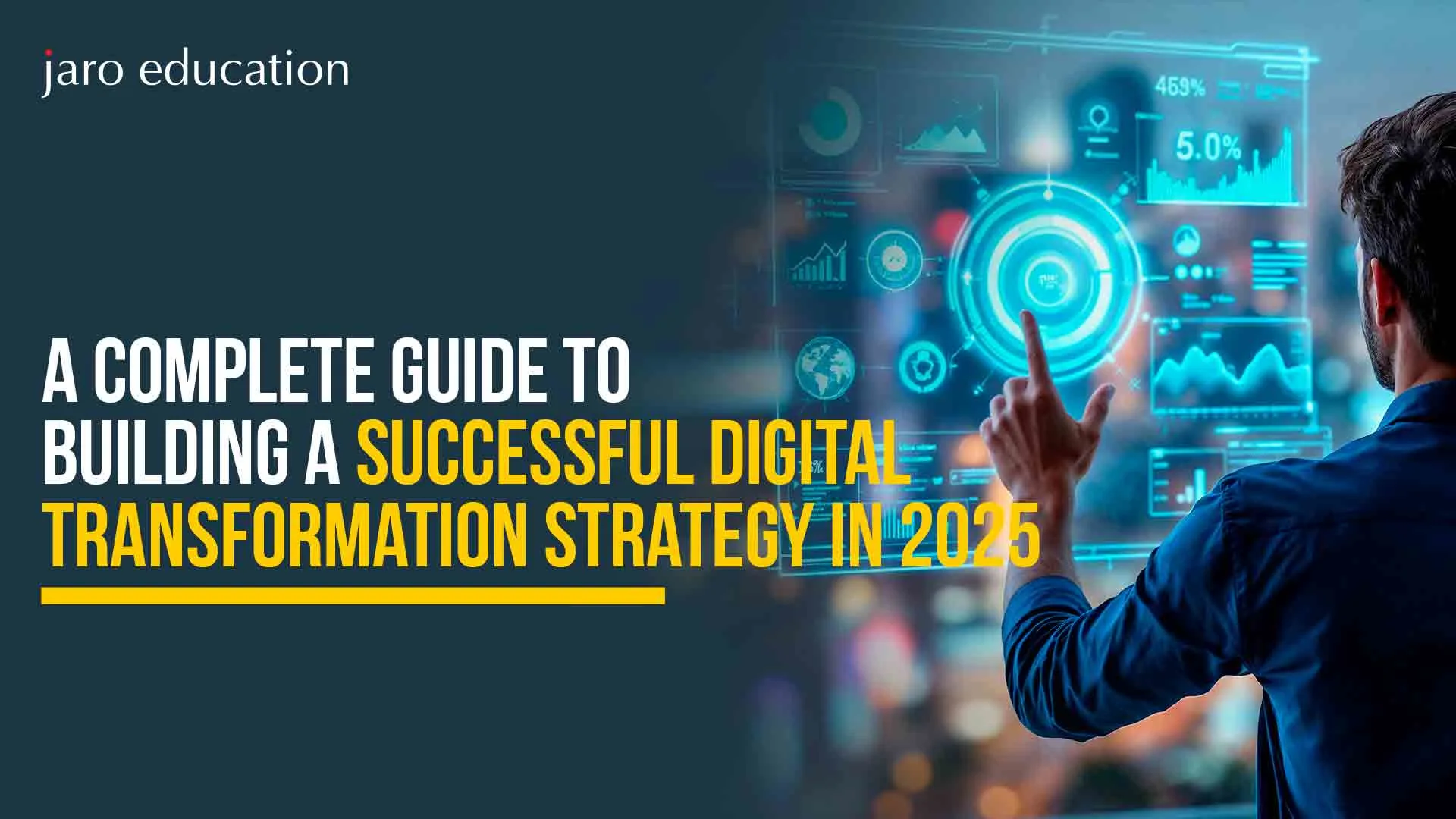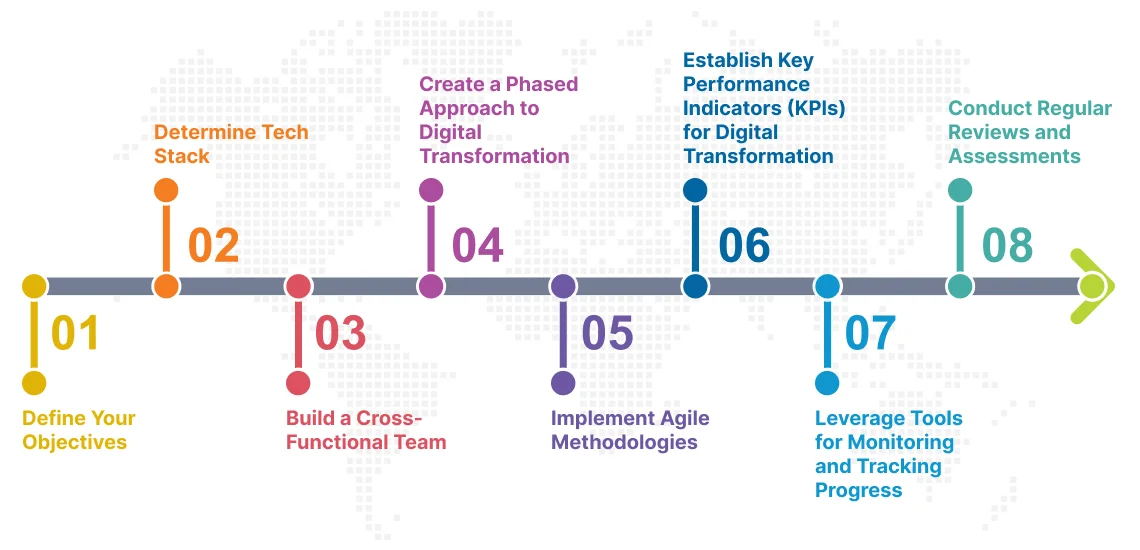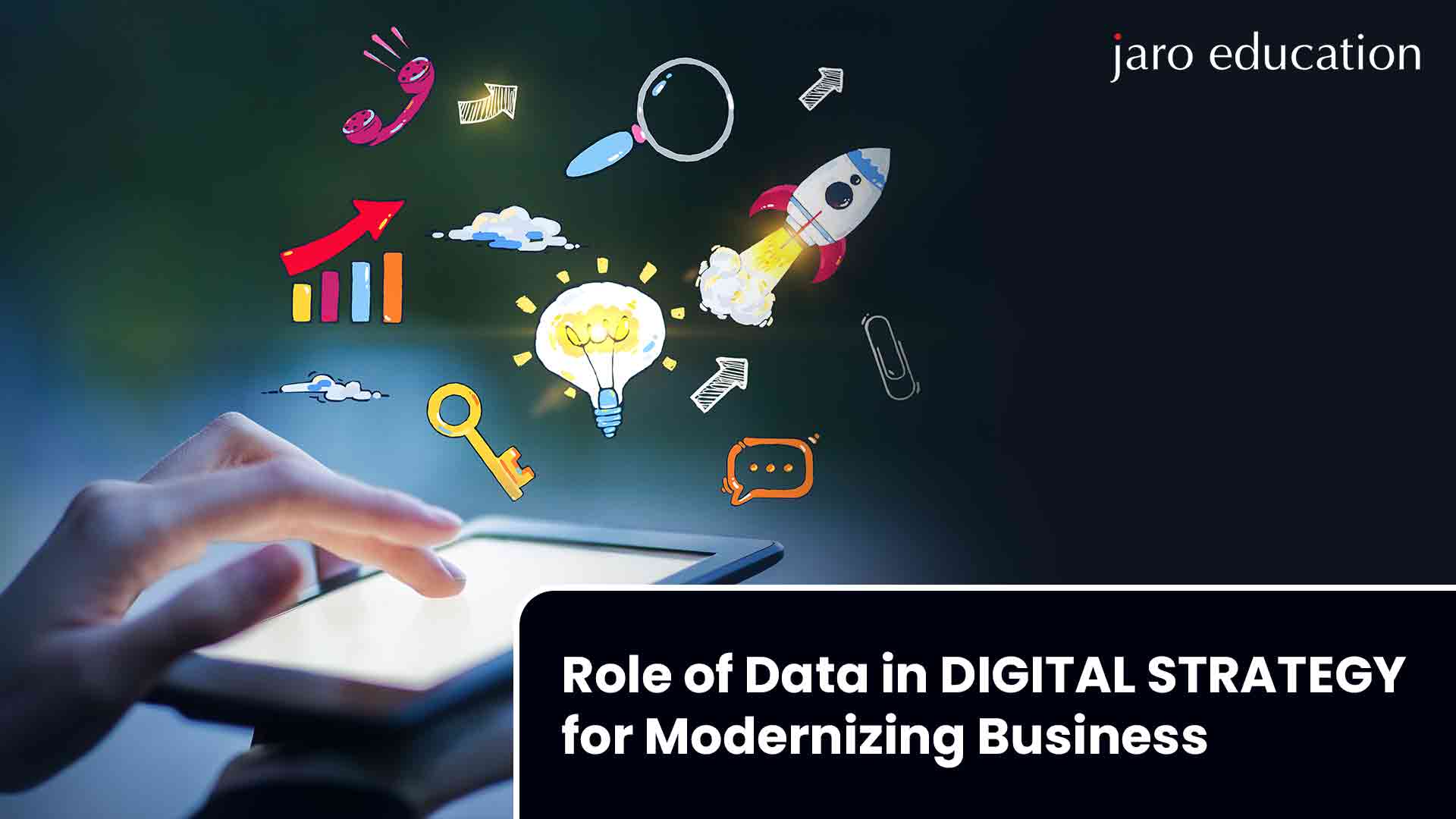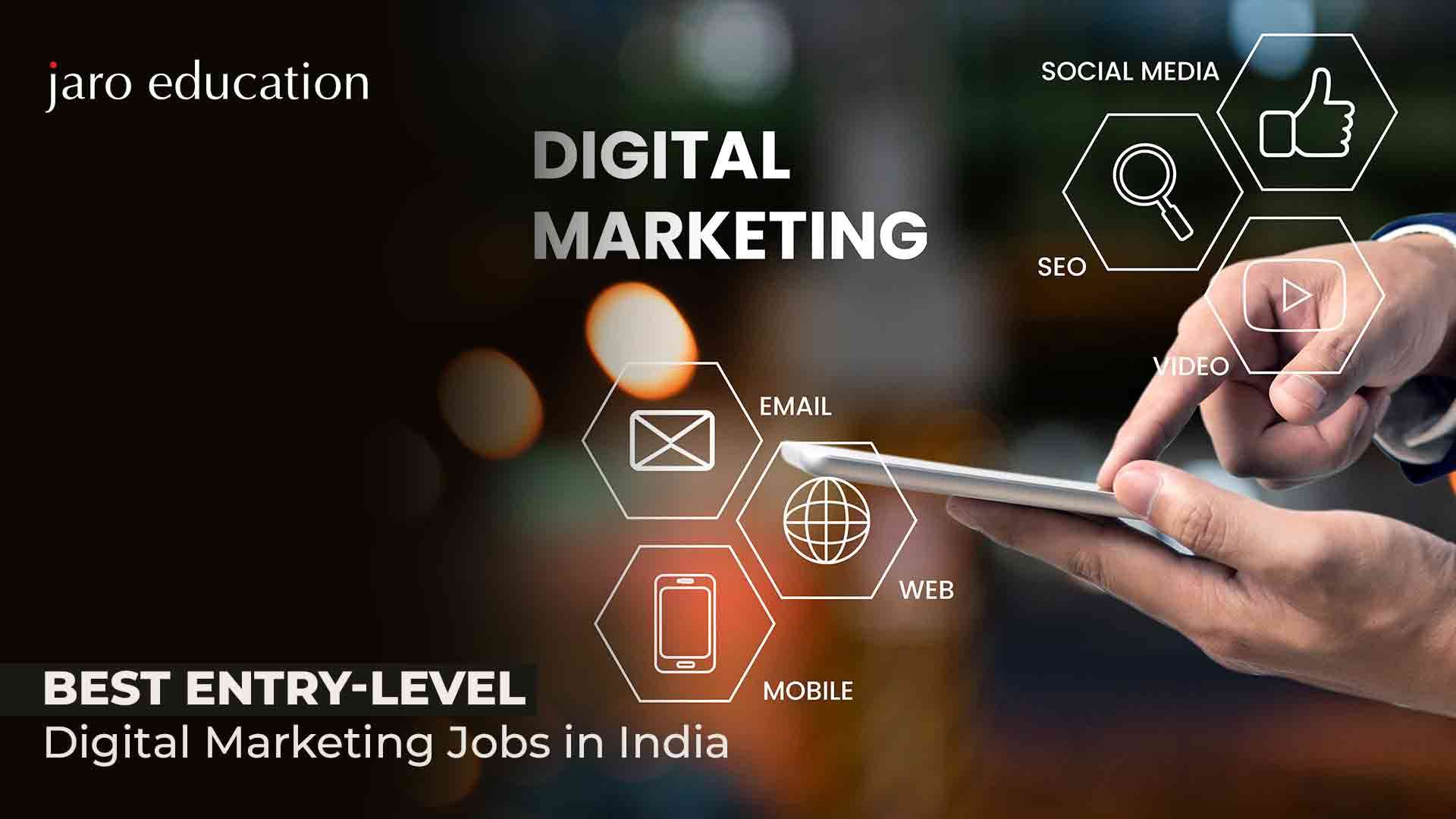A Complete Guide to Building a Successful Digital Transformation Strategy in 2025
Table of Contents

Technology is not only advancing at a rapid pace, but it is also accelerating. Businesses that consider digital change a “maybe later” project are quickly falling behind. In today’s always-connected world, companies have to adapt not just to survive but to stay relevant.
As 2025 unfolds, there’s no room left for delay. Creating a digital transformation strategy isn’t a nice bonus anymore—it’s a must-have if you want to compete and grow. Now, let’s be clear—digital transformation isn’t just about switching to cloud tools or throwing some AI into the mix. It’s about stepping back and asking, How can we use technology to rethink everything we do for the customer?
Therefore, building a strategy that works means shifting both your mindset and your operations. This guide covers all of it—from breaking down the digital transformation definition to walking through the actual steps you’ll need to take to make it work.

*smartway2.com
First Things First: What Is Digital Transformation, Really?
Before taking action, it helps to clarify what we’re actually talking about. So, what is digital transformation?
At their heart, digital tools and systems can help you rethink how your business functions and delivers value. It’s about more than tech upgrades—it’s about reshaping how your team works, how your customers interact with you, and how decisions are made.
This isn’t a surface-level change. Real transformation reaches every part of your business—finance, sales, HR, and supply chain—so nothing is untouched.
And by 2025, the digital transformation definition will have evolved. It’s no longer about just automating what you already do. It’s about redesigning the way your organization operates—more flexible, more customer-focused, and way more in tune with what’s coming next.
Why 2025 Is the Turning Point for Going Digital?
So, why is this the year to finally lock in your transformation plan?
The simple fact is that the landscape has changed fast. The ripple effects of the pandemic, the explosion of AI, and shifting customer expectations have rewritten the rules. Customers now want more than just service—they want fast, tailored, seamless experiences across every device. If you’re not delivering that, someone else will.
That’s why a clear digital transformation strategy is now critical. It has to do more than just handle tech—it must keep up with changing habits, support teams that work from anywhere, and build strong protection against cyber threats.
But there’s another layer too. A modern digital business strategy in 2025 must account for social and environmental responsibility. Younger consumers are watching—and they’re loyal to brands that share their values. So, your transformation needs to cover more than performance. It needs to show purpose, too.
Digitalization Strategy vs. Digital Transformation Strategy: Not the Same Thing
People often use “digitalization strategy” and “digital transformation strategy” interchangeably, but they are not.
Here’s the difference:
A digitalization strategy is about making current tasks easier with digital tools. Think online forms instead of paper ones, or moving files to the cloud.
But digital transformation? That’s a full reboot. It’s about changing how your business works at its core—maybe even what your business is. That might mean launching a new digital-first product, building a partner-driven platform, or reworking your entire supply chain for more flexibility and speed.
When companies don’t recognize the gap between the two, they risk doing the easy stuff and thinking they’ve transformed. But that’s just tech layering—not real change.
True transformation digs deeper—it changes how your people think, how your processes flow, and how your strategy unfolds.
15 Steps of Digital Transformation Strategy You Should Follow
Here are the 15 steps that will guide you in implementing your business’s ultimate digital transformation strategy.
Step 1: Define Your Vision and Goals
Every effective digital transformation strategy starts with a clear picture of where you want to go. Ask yourself: What problem am I solving? Is it streamlining processes, delivering a better customer journey, or branching into fresh markets? Your goals should be SMART—specific, measurable, attainable, relevant, and time-bound. And remember, to turn ambition into reality, you’ll need the backing of your executive team. Leadership endorsement is the lifeblood of any digital business strategy, so get your C-suite on board early and have them publicly advocate for change.
Step 2: Take an Honest Look at Where You Stand
Before you start planning where to go, it’s important to know where you are. That means taking a real, unfiltered look at your current digital setup. Are your tools outdated? Is your team comfortable with the systems they use? How easy is it for customers to interact with your brand online?
This kind of check-in, often called a digital maturity review, gives you a clearer picture of what’s working and what isn’t. Maybe your data is scattered, or maybe your internal processes are too slow. Whatever you uncover, these insights form the base of a strong digital transformation strategy.
It also helps to see how your business compares to others in your industry. Knowing where your competitors shine can help you decide what areas you might want to improve or where you can offer something better.
Step 3: Bring the Right People Together
When a company starts shifting toward digital, it shouldn’t be left to the IT department alone. In fact, the most effective efforts come from cross-department teamwork. That means pulling in voices from all over—sales, marketing, customer support, HR, finance, and more. Everyone brings something different to the table.
You’ll want tech-savvy team members and those who know how your current systems work. That balance helps avoid unrealistic ideas and makes the plan more grounded. A truly successful digital transformation strategy is built by people who understand both where the company is coming from and where it needs to go.
Step 4: Focus on What Your Customers Experience
Digital change should always lead to a better experience for your customers. After all, they’re the reason your business exists. If your systems speed up, but the customer remains stuck during checkout, there’s a problem.
Start by walking through your customer journey from start to finish. Where are the areas of difficulty? What could be smoother or more personal? Tools like AI or automation are helpful—but only if they make things easier and more engaging for real people. A modern digitalization strategy puts the customer at the center, not the technology.
Step 5: Pick Tools That Actually Help
It’s tempting to chase after every flashy new tech on the market. But not every tool will fit your goals—or your budget. What matters is finding the right match. Think about where your business is heading, not just what it needs today.
Cloud services, data platforms, and security tools are common pieces of the puzzle. But make sure they can grow with you. A strong digital business strategy uses tech as support, not as the driver. Your systems should be built to handle what’s next, not just patch up what’s broken now. That’s the heart of a smart, long-term digital transformation definition.
Step 6: Make Learning Your New Office Culture
Have you ever sat through a dry training slide deck and thought, “Ugh, not again”? Let’s flip that script. Think of digital skills like a team hobby—a weekly hackathon or a thirty-minute “lunch and learn” where people swap tips on a new app or hack together a tiny feature. Invite someone who’s never coded before to pair-program with your tech whiz just to see the lightbulb go on. That kind of casual, supportive vibe turns “training” into a social experiment everyone actually enjoys—and it fuels your entire digital transformation strategy by getting real humans excited about new ways of working.
Step 7: Turn Raw Numbers into Magic Moments
Data should feel like clues in a mystery novel, not pages of a spreadsheet. What if your customer service team saw in real-time which questions pop up most on your site? Or could your product folks watch a heat map of where people click inside your app? When you stitch together those nuggets—feedback forms, click trails, even IoT sensor alerts—you start spotting patterns that spark fresh ideas. That’s how data becomes more than a report; it becomes the engine of your digital business strategy, guiding every move from the homepage layout to the next feature launch.
Step 8: Weave Digital into Every Mission You Undertake
Imagine you’re planning a road trip: you wouldn’t map out the route, pick the playlist, and then throw in a car at the last minute, right? Yet, too often, companies do just that—define their big business goals and then bolt on tech as an afterthought. Instead, treat your digital transformation strategy as the base of your journey. If growing in new markets is Step One, ask, “Which digital channels and tools do we need to nail that?” When improving service is next, ask, “How can our digital roadmap make it effortless, delightful, and scalable?” Aligning digital and business goals from the very start keeps you headed in the right direction.
Step 9: Celebrate the Tiny Victories
No one throws a parade for a backend API rewrite, but they should. Pick one small project—maybe a chatbot that answers five of the most common customer questions—and get it live in a couple of sprints. Then shout about it: share before-and-after stats at your next town hall, send a thank-you GIF to the team, and post a quick “How we did it” thread on your intranet. Those early wins prove that momentum is real and give everyone a pep in their step. Before you know it, your digitalization strategy isn’t a distant plan—it’s a series of tangible, celebrated milestones.
Step 10: Keep Your Foot on the Grass—Forever
So, you rolled out that chatbot, revamped your data dashboard, and got the OK on a cloud migration. Fantastic. Now what? Stop calling transformation a “project” and start calling it a habit. Pick three metrics, for instance, speed of response, feature-release cadence, and customer satisfaction—and put them on a dashboard that updates every week. Make bi-weekly “check-and-adjust” sessions part of your rhythm, not an afterthought. When the market shifts or a hot new technology emerges, you’ll already have the muscle memory to pivot. That continuous, nimble approach is the beating heart of any long-term digital transformation strategy.
Step 11: Think About Cybersecurity Before It’s Too Late
Let’s face it—cyber threats aren’t just for tech departments to worry about anymore. The more your business goes digital, the more doors it leaves open. And the people trying to sneak in? They’re getting smarter every year.
That’s why cybersecurity can’t be something you deal with after something bad happens. By then, it’s too late.
So, what do you do instead? Start with the basics. Look for where things could go wrong—outdated software, weak passwords, or people clicking on links they shouldn’t. None of this is flashy, but it works.
Step 12: Make the Most of Data Without Getting Lost in It
Every business has data. There is an abundance of data available in every business. But here’s the thing—not all of it matters.
Rather than getting stuck in spreadsheets and dashboards, start asking better questions. What are you really trying to figure out? Maybe it’s the products customers love. Perhaps you are trying to understand the reasons behind the declining sales figures.
Once you know what you’re looking for, dig in. But don’t just stop at numbers—search for patterns, outliers, and things that seem off. Sometimes, a strange blip can reveal more information than a flawless chart could.
And remember, you don’t need to be a data scientist. Just be curious. Ask why, ask how, and ask what’s next.
Step 13: Bring People Along for the Ride
Technology doesn’t change a business—individuals do. If your team doesn’t support the changes, your strategy will not progress quickly.
So, how do you bring them in? Start by telling them why the changes matter. Don’t just talk in buzzwords—make it real. If a new tool makes someone’s job easier, say so. If it saves time, show them how. Then listen. You’ll be astonished by the extent of attention people pay—the positive aspects, the negative aspects, and the aspects no one previously considered.
Digital transformation isn’t a one-person job. Digital transformation is most effective when everyone is involved.
Step 14: Try Small Before Going Big
Not every idea has to roll out company-wide on day one. Instead, pick a test group. Maybe it’s one team or one department. Let them try things out, mess up, tweak, and improve. You’ll learn way more from a rough start than a perfect plan on paper.
When it works, scale it; when it doesn’t, fix it or scrap it. Either way, you’re making progress.
Smart companies in 2025 will not go all-in blindly. They will experiment first and move faster because of it.
Step 15: Keep Adjusting as You Go
A digital transformation strategy isn’t a one-and-done deal. Things change fast, and what worked last year might be useless next month.
That’s why you need regular check-ins. What’s going well? What’s falling flat? Don’t wait for a big quarterly review. Make it part of your normal rhythm.
Talk to the folks using the tools every day. Their feedback is gold. Maybe the system’s too slow. Maybe nobody’s using that new platform you thought would be a hit.

*mindinventory.com
Common Pitfalls to Avoid
Even the best-laid digital transformation strategy can falter if certain mistakes are made. Here are a few to watch out for:
- Lack of Leadership: Digital transformation requires strong support and involvement of top-level executives. If leadership isn’t prominent, that leads to a lack of commitment. It can also cause poor execution, low morale, and limited resource allocation. Thus, leadership must be prioritized for the sake of digital transformation strategy.
- Ignoring company culture: Every company has its own set of values, ethics, social norms, and habits. If a digital transformation doesn’t align with the company culture, the employees can’t adapt to the new changes. Thus, it’s crucial to make your employees accustomed to the new implementations.
- Tech overload: Adapting to too many new technologies without understanding them well doesn’t make sense. So, select only those technologies that your employees can handle efficiently and fulfil your needs. More significantly, you should integrate those tools that will help you reach specific goals and manage the challenges.
- Poor communication: Regular and transparent communication is essential for your digital transformation strategy. It helps to keep the teams and stakeholders well-informed and aware, and clarifies the changes and regular updates. If they are not communicated well, that can lead to confusion, which results in major faults. So, ensure there is consistent communication within the organization. Also, provide opportunities for the employees to ask questions and share feedback.
- Short-term focus: Digital transformation is not something that can be achieved in a single day. It requires lots of commitment, effort, time, and investment. Companies that are looking for immediate gains miss out on sustainable improvements. Thus, a true transformation requires vision, patience, and consistent refinement to achieve the desired long-term benefits.
Conclusion
In the future, the digital transformation strategy will be driven by emerging technologies like blockchain, AI, and quantum computing. So, businesses must stay adaptive and continuously evolve their strategies to fit the changing landscape. However, companies should maintain core principles such as agility, customer centricity, cultural alignment, and data literacy. Also, they must have a clear vision, adopt new tools, and upskill their employees to stay active in this long-term race.
Make Strategic Movement of Your Career with this Professional Digital Marketing Course
Thinking about where to start? How do we gain the basic concepts of the digital world? Here is a premium course for you– Professional Certificate Programme in Digital Marketing for Performance & Growth – IIM Kozhikode. IIM Kozhikode offers this course in collaboration with its marketing and technology partner, Jaro Education. They provide value-added educational services for their students, including learning support and unparalleled career guidance.
The curriculum of this programme includes an introduction to the digital world, digital marketing, digital marketing tools, SEO, e-commerce, social media marketing, and more. The programme has a practical learning approach with case discussions, live projects, and tool workshops. Some interesting features of the program are –
- 360-degree approach in digital marketing
- Utilization and enhancement of new immersive tools and technologies in the digital landscape
- Unique proven pedagogies
- 2 days campus immersion
Frequently Asked Questions
What are the four pillars of digital transformation?
The four pillars of digital transformation are adopting a transformative approach for the organization, transitioning from waterfall to agile methodologies, crafting a customer-centric approach, and integrating emerging technologies.
What are the components of digital transformation?
There are three key components of digital transformation: technical knowledge, changes in organizational capabilities, and consistent skill upgradation.
What is the golden triangle framework for digital transformation strategy?
The golden triangle for digital transformation consists of people, processes, and technology.


















